Adrian Collins's Blog, page 162
September 13, 2021
REVIEW: The Loop by Jeremy Robert Johnson
The Loop is a freaky story: a little bit War of the Worlds, a little bit Stranger Things, and a little bit, huh?
Have you ever heard of Turner Falls, Oregon? A typical little city with a population barely enough to call it a city. Probably not. It isn’t worth noting except for the weird quirk of having a plethora of Biotech corporations. That is the rub. What happens when a little tiny town and the teenagers who live there mix with biotech? You get The Loop.
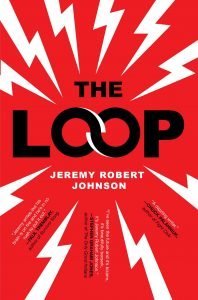 The Loop by Jeremy Robert Johnson is a weird little story that had me in the first fifty pages. It follows a typical body Snatchers type trope where the snatchers are bioengineered creatures instead of aliens. Except Johnson puts little twists on it here and there to keep the idea feeling fresh to readers. The way Johnson describes some of the scenes is pure body horror, and I am here for it.
The Loop by Jeremy Robert Johnson is a weird little story that had me in the first fifty pages. It follows a typical body Snatchers type trope where the snatchers are bioengineered creatures instead of aliens. Except Johnson puts little twists on it here and there to keep the idea feeling fresh to readers. The way Johnson describes some of the scenes is pure body horror, and I am here for it.
“You guys were the ones who thought it would be okay to pop a fucking octopus computer into somebody’s neck.”
Johnson took some of the big universal scares of humanity, things like tentacles that invade your body. They enter through your neck and break through your skull and shoot down your spine. These creatures remove your empathy and turn you into hive-minded machines bent on destruction. It is a great idea, especially in the beginning when a student is smashing a teacher’s face in with a book’s spine. What puts him into such a huge rage is not usual. Gore splatters the walls, and the students that witness the murder are forever altered by it. It wasn’t just a horror fest; there is character development and interest.
My main question in all this was why? The story did not have the deep plausible why that I needed as a springboard for the visuals. What was the point of the bioengineered monsters? Was it to control the teenagers? That seems a bit flimsy, and because that one bit of plot information eluded me, I could not fully immerse myself in the story.
Aside from the “big why,” that I spoke about above, there are many positives with The Loop. For one, the main character is a teenager but not the annoying angsty kind. Instead, the protagonist is the type who is just done with all this small town nonsense. Additionally, her banter and levity with the other characters kept rather brutal scenes lighter. And when I say Brutal, The Loop does not shy away from the dark and cruel. The writing and depth of horror reminded me a lot of the great Graham Masterton.
Sadly, even with the great writing, excellent gore, and engaging protagonist, I could not connect to the story on its most fundamental idea. These octopus spider things exist, but I don’t know why. This is my own quibble, as other reviewers who have read this story understood and embraced the biological scenario. But for this reviewer, I could never get past it, so it was a midgrade read for me.
Read The Loop by Jeremy Robert Johnson
The post REVIEW: The Loop by Jeremy Robert Johnson appeared first on Grimdark Magazine.
September 12, 2021
REVIEW: The Wisdom of Crowds by Joe Abercrombie
Having absolutely loved A Little Hatred and The Trouble with Peace, my expectations for The Wisdom of Crowds by Joe Abercrombie were absolutely sky high. With this gritty and fun book full of civil unrest, backstabbing, butchery, and even a little bit of love, Joe Abercrombie did not disappoint. A big thanks to Gollancz for shipping an absolutely gorgeous ARC over to me in Sydney, and a warning to readers who’ve not read the first two books: spoilers for the first two books to follow.
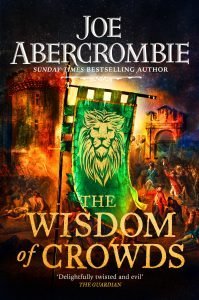 To kick off The Wisdom of Crowds King Orso returns to Adua at the head of his army and two prisoners, excited for his victorious reception. At the end of the column in a caged wagon, Leo Dan Brock is a broken man, with more than just metaphorical pieces of him left on the battlefield. Sabine dan Brock stares out at the streets through the bars, wondering where it all went wrong. None of them are ready for what’s become of Adua in their absence. The Breakers are out in force; the great change is here.
To kick off The Wisdom of Crowds King Orso returns to Adua at the head of his army and two prisoners, excited for his victorious reception. At the end of the column in a caged wagon, Leo Dan Brock is a broken man, with more than just metaphorical pieces of him left on the battlefield. Sabine dan Brock stares out at the streets through the bars, wondering where it all went wrong. None of them are ready for what’s become of Adua in their absence. The Breakers are out in force; the great change is here.
Vicktarine dan Teufel rides with the head of the People’s Army, on their way to Adua in their many, many thousands. People from all walks of life march on the capital of the Union to tear down the system and rebuild it into something better. Only, with a philosopher focussed on the ideal and not how to actually get there, and a judge more obsessed in killing everyone than actually trying cases, at the head of the Great Change, Vick is very much worried about where this is all going. But she’s picked the winning side, as she always does, and she’s going to see where this all lands.
Gunnar Broad is facing the hangman’s noose. He swears to live good life for his family if he somehow gets out of this alive. Under the Agriont in Adua, he likely doesn’t have long to live. Unless … something were to happen to the city to set him on a new course—directly into the type of the trouble he’d just promised to avoid.
Rikke sits in on Skarling’s Chair in Carleon, a city and army at her command, and somebody she probably needs to let her men kill in a broken heap in front of her. A decision to be made. Consolidate her winnings, or take on the father of the broken heap before her and unite the whole North?
Black and bloody and with a body count to rival Matthew Ward’s Legacy series, The Wisdom of Crowds delves into what happens when society has the restraints of civility completely removed (no matter how hollow and corrupt the Union’s civility had become). Recognising this book would have been conceptualised and drafted a fair few years ago, it’s seemingly landed at just the right time to align with our society. There is plenty of commentary on the removal of societal structure and norms, of what shackles-completely-removed freedom means for a people so used to corruption and profiteering, the human basic need to follow and what happens when certain new leaders grasp a people by the throat and lead, and the hilariously dark and infuriating bureaucratic machinery of government. Whether intentioned or not (I certainly won’t be the first reviewer to misread an author’s intended social commentary in a book), the prosecution character in the court of the people seems a perfect depiction of social media’s current mob mentality driven by the rise of misinformation and and lack of repercussions for outright lies the mob leaps upon.
Our leading characters and everyone around them are put through the wringer for a final time in this magnificent trilogy, in the brutal, sometimes comical, and often heart wrenching way that only Abercrombie delivers. And I assure you, plenty of those characters you know and love will either be dead or almost unrecognisable by the final pages–and that’s what makes this book and the trilogy it wraps up so damned good.
As always, Abercrombie does a masterful job of working in little nods to past books that delight his long term fans, but would just read like sleek world building for a new reader. There are plenty of nods to The Heroes and Red Country and the books of The First Law. In my eyes he’s a towering genius at doing this, and he has not missed the mark at all.
I also need to give a shout out to the last chapter. A vision of the future (and hopefully another future trilogy). Without spoiling, Abercrombie’s ability to deliver a clear message to the reader, even when he’s being purposefully vague about it, is on show in all its glory. I find that when compared to most other fantasy authors I’ve read who use the same approach that I either end up more confused than when I started, or just get frustrated and ask, “who fucking cares?” In the final chapter of The Wisdom of Crowds, Abercrombie provides me with an intense need to stalk his blog for news of the next book set in this world.
The Wisdom of Crowds is Abercrombie at his best. It’s fun, it’s engrossing, it’s brutal on its characters in all the best ways, and it’s just a damned enjoyable way to spend a few days glued to the pages of a book.
Read The Wisdom of Crowds by Joe Abercrombie
The post REVIEW: The Wisdom of Crowds by Joe Abercrombie appeared first on Grimdark Magazine.
REVIEW: Angels of Death: Trail of Blood
Deep in the Hive, the Blood Angels space marines continue to battle the masses of Tyranid cultists in the hopes of finding their captain in the latest release from Warhammer TV, Angels of Death: Trail of Blood. The first two episodes have really delivered an atmospheric story with plenty for fans to get in to, and I was really keen to see what episode three delivered.
On the ground, the Blood Angels drive through the enemy to try and reach their captain. Scenes are initially full of battle and action, and then, quite enjoyably, they take a bit of a slower turn as the detective work sets in. The writer and animators did an excellent job here of building up the tension as we try to figure out what happened to the captain.
In space, the situation worsens as the flagship flounders, stuck to the refuelling bay and unable to move. At the docking bay, armsmen battle more cultists, and the fighting is bloody, intensifying as the Blood Angels tech marine enters the fray to try to release the docking clamp. All is in the balance.
What really appeals about this episode is that we start to see a little bit more of a story develop. The Cult stops being an endless horde and starts becoming more and more sophisticated and calculating, drawing the Blood Angels in, one step at a time, like an apex predator drawing in prey.
The flamer scene was particularly awesomely animated, and warrants a special mention. The white heat, screaming cultists, and a Blood Angel charging through, flamer gouting, was utterly glorious.The sounds of battle felt like they didn’t quite invest in enough layers of sound at times, especially in the loading bay conflict. It also seems so weird that the smaller ships that were supposed to be attacking the flagship just didn’t … well … shoot?
Apart from a couple of complaints, the story is really starting to grab me. In the void above it’s much of a muchness to me, but on the ground, in the guts of the hive, we are starting to see something that could be brilliant. Bring on next Wednesday!
Watch Angels of Death: Trail of BloodThe post REVIEW: Angels of Death: Trail of Blood appeared first on Grimdark Magazine.
September 11, 2021
REVIEW: The Burning Girls by C. J. Tudor
The Burning Girls by C. J. Tudor is an evocative read which kept surprising me throughout. The story centres around a village in rural Sussex where Rev. Jack Brooks and her teenage daughter Flo are bidding for a fresh start after a series of recent traumas. Their new surroundings cut a stark contrast against their home city of Nottingham and adjusting to the change of pace is a challenge for them both.
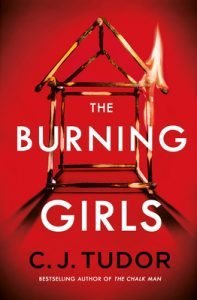 Upon their arrival, Jack and Flo are greeted with vestiges of the village’s ties to The Sussex Martyrs –infamous locals who were burned for their beliefs half a millennium ago. The churchyard is adorned with effigies (handmade from twigs, Blair Witch style) which locals craft every year to memorialize those who were slain at Queen Mary’s bidding on their very doorstep.
Upon their arrival, Jack and Flo are greeted with vestiges of the village’s ties to The Sussex Martyrs –infamous locals who were burned for their beliefs half a millennium ago. The churchyard is adorned with effigies (handmade from twigs, Blair Witch style) which locals craft every year to memorialize those who were slain at Queen Mary’s bidding on their very doorstep.
An exorcism kit and a threatening note are left as gifts to welcome Jack into the close-knit community which she is to call her flock. When Flo then begins to see horrific apparitions of the 500-year-old victims which give the book its title, one could be forgiven for thinking that we are in all too predictable territory.
Tudor, however, is a master of her craft and it soon becomes clear that tropes are cast with skill. This tale blurs the genres (horror, thriller, mystery) in a way which mirrors the distortion of good and evil faced by the characters as Jack attempts to unravel her predecessor’s role in the disappearance of two young girls thirty years ago. The mystery intensifies and the stakes soar. I found that I was heavily invested in Jack’s predicament early on. This, coupled with the crisp prose and taut chapters, made for a pacy read which I finished in only a few sittings.
As well as malicious neighbours and paranormal entities, elements of what happened in their previous big city life stalk Jack and Flo both literally and metaphorically at every turn. But again, the delivery and execution (pardon the pun) are key in making this a gripping read. One of my favourite takeaways from the book was how it chewed up and spat out my natural attempts to predict the ending.
A labyrinth of twists and turns with menace at every curve, this is Tudor’s best offering yet. I thoroughly enjoyed this yarn, and you will too if you appreciated 2018’s The Chalk Man or recent GdM recommendation The Last House on Needless Street by Catriona Ward.
Read The Burning Girls by C. J. Tudor
The post REVIEW: The Burning Girls by C. J. Tudor appeared first on Grimdark Magazine.
September 10, 2021
REVIEW: Angels of Death: Silent City
The Warhammer+ Angels of Death series danger and action ramps up quickly in episode two, Silent City. The Blood Angels drop through blanketing storms into a hive city they cannot see to save their captain.
As the Blood Angels enter the seemingly empty city and start searching for their captain, we get our first look at the hive city, and it is stunningly detailed in grim greyscale. The gothic feel of the hive city is perfect for the world of Warhammer 40,000 that I grew up playing, painting, and reading about. Again, as I said in my review of E1 Blood and Duty, the art and the colour palette of blood red against greyscale is utterly gorgeous.
In space, the Blood Angels flotilla is infiltrated. Void shops are being taken over and turned against the flagship—where all the geneseed of the company is held and protected by a lone techmarine.
While we as viewers know it’s the Great Devourer as a foe, this is when the Blood Angels first understand the scale of their opponent. The Tyranid horde have invaded this city, turned the people against the Imperium of Mankind, and now potentially billions of foes await, standing between them and their captain.
Overall, Silent City is an excellent set up for a pitched city battle. While some of the fight action seemed a bit stilted in movement, overall the visually stunning animation retained its grit and ability to visually carry the story. The sense of trepidation and growing pressure was done really well, and I finished Silent City really looking forward to more Angels of Death. I can’t wait to see what happens next.
Watch Angels of Death: Silent CityThe post REVIEW: Angels of Death: Silent City appeared first on Grimdark Magazine.
September 9, 2021
REVIEW: Observer: System Redux
Observer: System Redux is a cyberpunk horror game produced by Blooper Team and published by Aspyr. I was initially hesitant to play the game due to the fact it supposedly was a “walking simulator” and had very little gameplay. In fact, I have nothing but high praise for the game as a puzzle game and my only real complaints about it are its very short stealth sections. It is perhaps not the best endorsement that the worst parts of the game are the gameplay but Observer more than makes up for it in atmosphere, tension, and world-building. Oh yes and being one of the final performances of Rutger Haur.
 You play as Daniel Lazarski, a cybernetically enhanced special investigator for the Chiron Corporation in what remains of Poland after what seems like multiple apocalypses. A horrifying disease called the Nanophage and nuclear warfare has reduced much of the world to ashes with Poland not doing much better. Daniel decides to investigate the apartment building where his son lives due to a series of murders there that he’s (justifiably) terrified may have taken their child’s life. Thus he sets out on a mission to explore the monstrously twisted Stacks and find out who is killing residents and whether his son is still alive.
You play as Daniel Lazarski, a cybernetically enhanced special investigator for the Chiron Corporation in what remains of Poland after what seems like multiple apocalypses. A horrifying disease called the Nanophage and nuclear warfare has reduced much of the world to ashes with Poland not doing much better. Daniel decides to investigate the apartment building where his son lives due to a series of murders there that he’s (justifiably) terrified may have taken their child’s life. Thus he sets out on a mission to explore the monstrously twisted Stacks and find out who is killing residents and whether his son is still alive.
Daniel is an old man and his enhancements basically just keep him moving around rather than turn him into a superhuman. Instead, his primary advantage is the dream-eater that allows him to enter the minds of other people and experience their emotions. Unfortunately, if you link with the recently dead then you will not get the answers you want but instead experience a nightmarish hellscape of confusing imagery. Basically, the game’s central mechanic makes it into a cyberpunk version of Silent Hill.
The comparison to Silent Hill is high praise from me as the psychadelic journeys that Daniel’s mind goes through are fascinating. One of my favorite is when he has to upload himself into the minds of an office drone trying to make a legitimate living in the corporate world while her boyfriend is a low-level drug dealer that has served time in prison. Seems pretty boring, right? Nope. Terrifying visions of offices from Hell and prison nightmares plus a wedded life that would permanently turn you from the institution due to it being a match match in the 9th circle.
While the craziest stuff is in the dreamscape portion of the game, the Stacks are pretty nightmarish on their own. A decaying apartment building where rats would hesitate to live, the place is full of seedy and horrifying side stories about technology gone amuck. One apartment has an illegal organ growing ring where they keep a horribly mutated pig in a virtual reality chamber where it thinks its enjoying life in a sunny field. Another one has an autistic girl that a rich old woman is caring for but may (or may not) be planning to steal the body of via brain uploading. It’s a crazy cyberpunk world where the nicest family you meet are a bunch of religious fundamentalists.
As stated, the game has one flaw and that’s the stealth sections where the developers attempted to insert some gameplay but actually made a ridiculously frustrating and counter-intuitive thing that made me rage quit the game a couple of times. These sections are effectively passed as much by luck as anything else and are the worst parts of what would otherwise be a perfect creepy game of pure atmosphere and puzzle-solving.
In conclusion, I definitely recommend this game. Rutger Hauer’s performance is spot on and he gives a tired, resigned, but noble performance that perfectly fits his character. There’s not many old men as protagonists in video games or cyberpunk but it works perfectly here.
Play Observer: System Redux
The post REVIEW: Observer: System Redux appeared first on Grimdark Magazine.
September 8, 2021
REVIEW: Half the World by Joe Abercrombie
Half the World is the second instalment in Joe Abercrombie’s fantastic Shattered Sea trilogy. I was very glad that when I first read the series I was able to pick this up as soon as I had finished its predecessor Half a King. It is as gripping and engrossing as I had expected and this entry became my favourite of the trilogy. However, I believe that Half the World could stand on its own spine and although reading it as the second novel greatly adds to the depth of a reader’s enjoyment and understanding it is not absolutely essential.
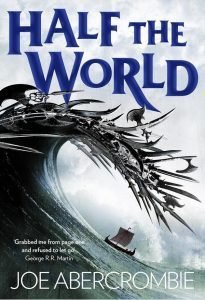 In Half the World Abercrombie maintains the same fast pace and clever prose that he established at the start of the series. But there are some big changes from the first page that drastically alter the dynamic of this novel. The half handed Prince Yarvi is now Father Yarvi, Minister to the King of Gettland. He remains a significant character, but Half the World has more of an ensemble company of key characters instead of one clear protagonist. This variation in perspectives is a change that I personally quite like. I enjoyed Yarvi’s narrative in the last novel, and he remains a cunning genius in this one, but watching his plans unfurl from the viewpoint of other characters rather than from the mastermind himself gives Half the World a different, less omniscient, feel.
In Half the World Abercrombie maintains the same fast pace and clever prose that he established at the start of the series. But there are some big changes from the first page that drastically alter the dynamic of this novel. The half handed Prince Yarvi is now Father Yarvi, Minister to the King of Gettland. He remains a significant character, but Half the World has more of an ensemble company of key characters instead of one clear protagonist. This variation in perspectives is a change that I personally quite like. I enjoyed Yarvi’s narrative in the last novel, and he remains a cunning genius in this one, but watching his plans unfurl from the viewpoint of other characters rather than from the mastermind himself gives Half the World a different, less omniscient, feel.
The key themes of the novel remain the same: Yarvi is still bound by his vow to avenge the deaths of his father and brother, the Shattered Sea is still surrounded by unstable and violent kingdoms, and Abercrombie has still stitched in wonderful details to his plot that are a joy to read at the time, but even more clever when you can finally take in the whole tapestry that he has created. It is a delightful skill when authors are able to discreetly leave a subtle trail secrets about the bigger picture of the plot and not something I could fully appreciate until I reread this series.
On the first page of Half the World we meet two of the new central characters, the war hungry Thorn Bathu, desperate to prove herself and win a place in the King’s raiding party, and the young warrior Brand, who is strong and skilled but does not have the heart to kill. This unlikely duo quickly find themselves woven in to Father Yarvi’s schemes and the three of them become part the crew on another sea faring voyage across the Shattered Sea. This gruelling voyage is where the title of the novel is taken from, as Abercrombie does indeed take them from one half of his world to the other in the mission for Yarvi to gather allies for Gettland in its continued fight against the High King.
As one would expect from any Abercrombie offering, Half the World is riveting from the get go. The battles are bloody and violent and the action moves quickly but equally the lulls in between show the humanity and humour of the characters. It is an intense read with no easy place to put it down, so when you open it up expect a late night.
Read Half the World by Joe Abercrombie
The post REVIEW: Half the World by Joe Abercrombie appeared first on Grimdark Magazine.
REVIEW: Hammer and Bolter: Old Bale Eye
In Old Bale Eye, the latest episode of Warhammer+’s Hammer and Bolter, an orc leader (a “Nob”) tells two of his boys the story of when the ork warlord Gaskull Thraka took on Old Bale Eye (known to Imperial fans as the great Commissar Yarrick). Essentially, this is mostly the story of the legend of Yarrick, from the Orks perspective. And it’s actually a really cool way to present the story.
Orks are an odd faction, primarily a comedic kind of army. They are a green horde of pure muscle and aggression strapped with looted and bootlegged weapons of often ridiculous firepower. And they love a good scrap. They live for it and chase it. They are fun, a bit silly, and I honestly don’t see much of an opportunity for their character growth to drive much interest outside of the ork-specific fan base. It’s probably why there aren’t many ork-POV Black Library books.
But in Old Bale Eye they are shown to be storytellers—a method of passing down history that I think is really cool and a believable method of history recording for the faction. The story definitely lands as our Nob talks of battles long past and a rivalry of epic proportions that chews up orks and men in their millions as one chases the other across the galaxy.
One thing I wasn’t a fan of in Old Bale Eye was how both factions—human and ork—spoke the same language. I thought it would have worked better to have the humans shouting at the orks in gibberish, personally. There was also a twist in the story that, well, I’m not sure if it’s an older piece of lore that hasn’t been written out of the more modern lexicon, but seemed to push the suspension of disbelief just a bit too far for me.
Old Bale Eye is an interesting episode, and one I think that’ll definitely appeal to the ork faction fans more than others. It may also appeal to those Yarrick / Guard fans. Overall a great concept for delivery of an ork story, and once again I am really excited to see what next week’s of Hammer and Bolter brings.
You can find out other Hammer and Bolter reviews here.
Watch Hammer and Bolter: Old Bale Eye on Warhammer+The post REVIEW: Hammer and Bolter: Old Bale Eye appeared first on Grimdark Magazine.
September 7, 2021
REVIEW: Unity by Elly Bangs
Imagine if humans could perfectly understand one another. What if science opened the possibility for us to transcend the need for language, creating true empathy? What implications would exist if technology could synthesize a collection of human consciousness? Unity by Elly Bangs examines the possibilities and casualties of total homogeneity, and its impact on personhood.
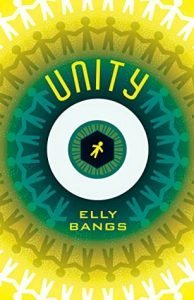 Danae is twelve thousand years old and is among those who have unified. She is a confluence of all memories and experiences from two hundred and twenty-three people. I loved how Unity pushes the boundaries of the human mind. To fully Unify, the individuals’ minds cease to exist, and a new consciousness is born. Joining other science-fiction stories such as Altered Carbon, Dollhouse, and Cyberpunk, Unity continues exploring the theme of consciousness with new thought-provoking questions.
Danae is twelve thousand years old and is among those who have unified. She is a confluence of all memories and experiences from two hundred and twenty-three people. I loved how Unity pushes the boundaries of the human mind. To fully Unify, the individuals’ minds cease to exist, and a new consciousness is born. Joining other science-fiction stories such as Altered Carbon, Dollhouse, and Cyberpunk, Unity continues exploring the theme of consciousness with new thought-provoking questions.
Unity begins with Danae fractured from her other selves and desperate to rejoin them in their homeland, Redhill. As she journeys, she reflects on her traumatic past and her renewed sense of mortality. Her path to Redhill is suicide as bounty hunters and a stalker haunt her steps. New threats place an already post-apocalyptic world in peril.
While Unity primarily focuses on Danae, the other two point of views in this novel are equally compelling. Alexei is an ex-mercenary hired to smuggle Danae and her love, Naoto, safely home. If Danae is a collaboration of everyone she had ever unified with, Alexei is plagued with the guilt of everyone he had murdered. The third point of view is dubbed The Borrower, though he could be called other more accurate, more ominous names. While Danae unifies with willing participants, The Borrower forces his personhood into others.
Elly Bangs’s apocalyptic, cyber punk novel is a bold debut. Its world building and themes are immense in scale. Piecing together this world’s catastrophes and politics as I read was challenging, especially in the beginning. At some points, the dialogue felt rather over-explained which harshly contrasted to the complex story. This novel does hit its stride and come together a quarter of the way in. Overall, I was enthralled by the themes and scene imagery in Unity.
Elly Bangs had revised Unity over the course of eighteen years, radically changing the story as she protested wars, endured economic collapses and climate change, and witnessed the global pandemic of our times. Her vision of consciousness and self-identity is powerful. I would be intrigued to read her next novel.
Read Unity by Elly Bangs
The post REVIEW: Unity by Elly Bangs appeared first on Grimdark Magazine.
REVIEW: Hammer and Bolter: Bound for Greatness
In Bound for Greatness Adept Neath counts books at an Imperial librarium. He’s not allowed to read. He’s not allowed to talk. His job is one of repetitive boredom, and of commitment to the Imperium and the Emperor. He counts the books, he makes sure the right number is there, and he prays with all the faith he can muster.
His world is turned upside down when he realises that sometimes there are the wrong number of books, and a fellow adept confronts him about the missing books. Shadows haunt the book stacks, but can Neath uphold his Imperial faith?
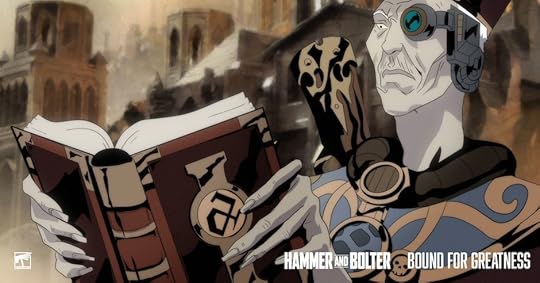
Bound for Greatness is a story that highlights both the ridiculous beurocracy of the imperium, and the insidious nature of the spiritual enemies of humanity. And, in a consistent theme of the 40k universe, how the former enables the latter.
Reminding me of Castlevania in its animation style, this episode is definitely a slow burn (as much as possible for a 17-minute-and-change episode) and won’t appeal to people who follow 40k for buzzing chainswords, hamming bolters, and colossal void wars. It will appeal to those who love the Chaos faction and it’s insidious nature. Not always are worlds won with fiery combat; sometimes it’s with quiet infiltration and the promise of change in a galaxy that has grown stale and stagnant.
The message Bound for Greatness carries is a key one for the 40k universe and 40k lore. It speaks of the common Imperial citizen (one of the countless many) and how hiding them from the horrors of the universe maybe protects them, and maybe leaves then undefended against them.
Another interesting episode for Hammer and Bolter. I’m glad I watched Bound for Greatness, but I’m equally glad it was a short episode, as it’s not quite my jam. I can’t wait to see what’s next.
Watch Hammer and Bolter: Bound for Greatness on Warhammer+The post REVIEW: Hammer and Bolter: Bound for Greatness appeared first on Grimdark Magazine.





